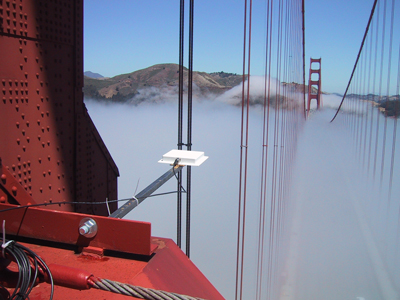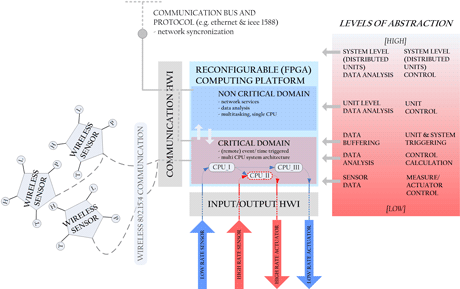by Steven D. Glaser and Tommi Parkkila
At the Center for Information Technology Research in the Interest of Society, University of California, Berkeley, USA, we have been developing and deploying wireless sensor systems for ten years. We have focused on solutions to societal needs. As we ask more and more from our 'motes' and their low-power networks, we foresee important applications for sensor and control networks that will require a more powerful and flexible solution.
The system we propose, AdapSys, is based on a fundamental unit that can perform at a very high level of abstraction - a multi-level controller and sensor hub that is completely software reconfigurable, including basic and ancillary functionality. In this scheme, each unit can act as a single complex controller as part of a locally controlled mesh, which in turn can be part of a wider distributed or hierarchical control network. All elements of this system consist of the same hardware, but have fundamentally fluid behaviors based on software adaptivity and reconfigurability.
We want to know what our structures are doing: structures in the big sense, from our bodies up to large industrial processes, airframes and buildings. This has traditionally been a troublesome and expensive problem. Recent improvements in sensors based on Micro-Electro-Mechanical Systems (MEMS) and in wireless technology have allowed the proliferation of wireless sensor networks, and these have completely changed what we can measure. Each element of the network is commonly called a 'mote' or smart sensor. Motes are combined into large networks that allow dense and detailed sensing. These networks move beyond the idea of a sensor as a single instrument measuring one thing, to a comprehensive system consisting of many small nodes working cooperatively. Engineering and science, however, remain captive to the traditional hierarchical embedded system. This experience has led us to devise a new monitoring and control appliance, each interacting in an organic network.

Here is an example of the current state of practice. During 2006 a mote network was designed, implemented, deployed and tested on the Golden Gate Bridge in San Francisco, in order to monitor its structural condition. Sixty-four motes were distributed over the main span and southern tower (see Figure 1), comprising the largest wireless vibration sensor network ever installed for structural health monitoring purposes. The spatially dense array resulted in an increase in effective signal-to-noise ratio compared to single, isolated, sensors, and most importantly allowed the higher modes, both vertical and torsional, to be analyzed easily and accurately.
Deep Underground Science and Engineering Laboratory (DUSEL)
DUSEL is a large physics and engineering laboratory being constructed in the old Homestake gold mine in Lead, SD, USA. We are developing a deep in situ seismic observatory that will move us closer to the realization of rapid imaging of dynamical geo-processes at depth. More than 12 000 small-diameter (~ 65 mm) exploration holes exist throughout the mine, which we intend to use as multi-point monitoring probes. Any motion in the rock mass is thus surrounded by multiple receivers, which greatly constrains the inversion back to source movements. This solution led us to propose the AdapSys appliance.
AdapSys
AdapSys is an elegant, straightforward, flexible and reconfigurable system comprised of Field Programmable Gate Array (FPGA)-based units. Each AdapSys unit is: (i) a real-time multi-channel data acquisition platform; (ii) a multi-sensor data aggregator; (iii) a remotely reprogrammable multilevel controller; (iv) highly portable; (v) distributed; and (vi) an embedded sensing and control network solution. We envision a group of AdapSys units controlling, say, a large paper mill, public conveyance systems, public safety equipment during a natural or man-made disaster, or even an array of wind generators with built-in nondestructive evaluation systems.
AdapSys uses a single FPGA to orchestrate and carry out the application demand through sensing, control and computation. AdapSys is a compound of flexible, reconfigurable, FPGA-based fundamental system units (see Figure 2). One of these units can execute the functionality of several micro-controllers through its multi-processor capabilities. New functionalities can be added to the system as parallel self-contained processor units inside the single FPGA chip. This allows the system to be incrementally upgraded in the field while allowing support of modular verification and certification.

Analyses of the DUSEL results along with past experience show that improved seismic arrays can be constructed from a string of accelerometer pods installed along a bore hole. We are currently prototyping down-hole sondes based on an Altera FPGA. The device has 24 input channels, both analog and digital, with a virtual real-time machine for each. Within the FPGA there are also real-time machines for the real-time clock, bus handling, and numerous control loops. All memory functions are handled seamlessly within the FPGA. Because the heart of the sonde is now software on the FPGA, there is little need for upgrades to entail physical hardware replacement; a completely new set of machines can be implemented by installing new software over the Web.
The AdapSys prototype is currently being assembled at the VTT Laboratory in Oulu. We are planning a joint research project with companies from the machine and automation industry in Finland, in order to test and refine the system in actual field situations.
Please contact:
Steven D. Glaser,
Center for Information Technology Research in the Interest of Society,
University of California, Berkeley, USA
E-mail: glaser![]() berkeley.edu
berkeley.edu
http://www.ce.berkeley.edu/~glaser
Tommi Parkkila
VTT - Technical Research Centre of Finland
E-mail: Tommi.Parkkila![]() vtt.fi
vtt.fi










